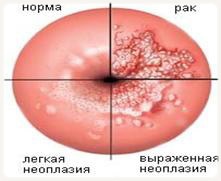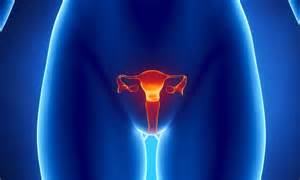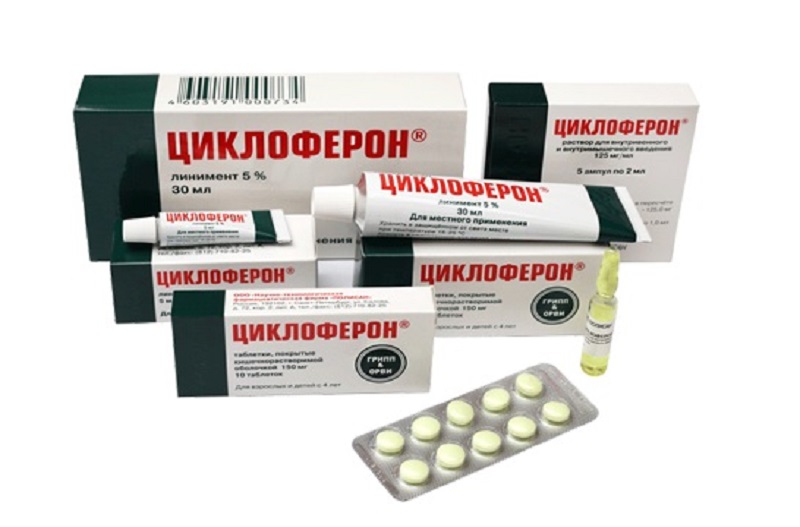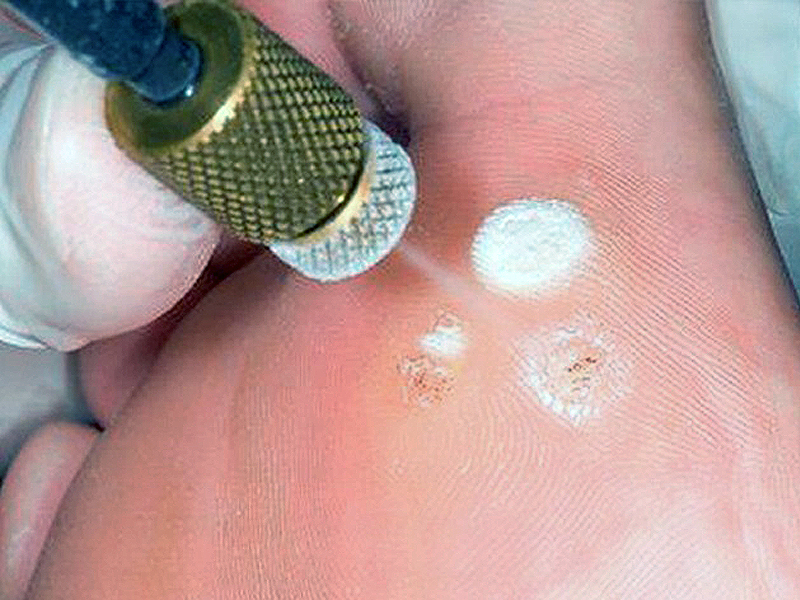HPV is considered to be tropic primarily to the basal layer of the epithelium, which lines the skin and mucous membranes. According to statistics, more than 90% of the world's inhabitants are carriers of this infection, although not everyone has obvious symptoms. In addition, even when growths appear on the body, they differ in different morphological structures. This is explained by the fact that different strains of the pathogen can lead to the development of the disease, and more than 100 of them are known.
Among all types, HPV types 16 and 18 are considered one of the most dangerous, as they belong to the category of highly oncogenic. In the presence of these strains, there is a significant risk of the formation of malignant processes, and patients are susceptible to them, regardless of age and gender.
Why is papilloma (HPV) type 16 dangerous: photo
 Upon penetration into the cell, the pathogen may exist for some period without any manifestations. Initially, it does not affect the DNA of epithelial structures. The pathological process develops after the activation of HPV type 16 under the influence of provoking factors. At the same time, HPV type 16 DNA penetrates the genetic structures of the cell and reprograms them. As a result, the division process is disturbed, atypical cells begin to grow, which form a malignant tumor.
Upon penetration into the cell, the pathogen may exist for some period without any manifestations. Initially, it does not affect the DNA of epithelial structures. The pathological process develops after the activation of HPV type 16 under the influence of provoking factors. At the same time, HPV type 16 DNA penetrates the genetic structures of the cell and reprograms them. As a result, the division process is disturbed, atypical cells begin to grow, which form a malignant tumor.
What does papillomavirus 16 mean? If, during the examination, a specialist identified a given strain of the pathogen in the body, this does not mean at all that the patient is suffering from oncology. In the absence of signs of cancer, such a result only increases the risk of developing malignant neoplasms, and in order to prevent this process, therapeutic measures should be taken immediately to eliminate papillomavirus 16.
It is also worth noting that type 16, 18 papilloma poses the greatest danger to the reproductive sphere, as it can lead to cancer of these structures. Both women and men are at risk. Therefore, it is better to periodically undergo an examination and refuse casual sex.
How does infection with human papillomavirus types 18 and 16 occur?

What does HPV 16, 18 mean and where did it come from? This question is asked by most patients after receiving a positive test result. You can become infected with the pathogen only through close contact with the carrier of the infection.
Papillomaviruses 18 and 16 strains enter the body in the following ways:
- sexual - during sexual contact without using a condom, although this method does not completely protect against infection with HPV type 18 and other types;
- household - transmission of microorganisms through any objects or upon contact with biological fluids, the entrance gates for type 16 papillomavirus are wounds, scratches, minor damage;
- from mother to baby during the process of delivery - the danger for the baby in terms of infection with the human papillomavirus 16, 18 is represented by both physiological birth and cesarean section (the child may subsequently develop growths on the respiratory tract, genitals, mouth, anal area) ;
- self-infection - the carrier of the infection is capable of transferring the papilloma virus 16, 18 from one part of his body to another if sanitary standards are not observed.
You can catch the pathogen in different ways, sometimes without even knowing about the possible danger, for example, when visiting a public swimming pool, bathhouse, or sauna. Therefore, do not forget about basic hygiene rules.
Stages of development of human papillomavirus (HPV) 16, 18: photo

After the pathogen penetrates the cells, its life process can be divided into several stages, each of which differs both in the processes inside the affected structure and in the external signs of infection. The disease occurs in 4 stages:
- Incubation period. HPV 16, 18 is in “sleep mode”. There are no changes in the body; the infection can only be determined by PCR. The duration of the latent period varies from 2-3 weeks to tens of years. The activation of the virus is influenced by a lot of negative factors, under the influence of which a decrease in immunity occurs.
- Stage of clinical manifestations. This stage is characterized by activation of the infection and the beginning of intensive cell division. As a result, type 16 papillomas appear on the surface - growths that rise above areas of healthy tissue. The disease can be diagnosed using cytology and histology.
- Dysplasia. The third stage of the development of the disease is characterized by the penetration of the high-risk HPV genotype (16, 18) into the nucleus of the affected cell and changes in its vital processes. Under the influence of a pathogenic agent, all structures change their size, in their structure they resemble cancerous elements. When examining the material under a microscope, it is possible to detect DNA particles of HPV 16, 18. Also, there is a concentration of nuclei in one place, if we are talking about multinuclear cells, the so-called "enlightenment" zones are characteristic, which are characteristic of oncological tumors. If type 18 papillomas are detected at this stage, it is important to immediately begin treatment, since the process of development of oncopathology has already been launched.
- Cancer. The DNA of papillomavirus type 16 is fixed in the genetic material of the affected elements and causes irreversible mutations, which leads to the formation of malignant neoplasms.
If human papilloma type 16 or any other strain from the HCR group is detected at an early stage of development, the pathological process can be completely stopped. The sooner specific therapy is started, the easier it is to avoid serious consequences.
Clinical manifestations of human papillomavirus types 16, 18: photo

After the microorganism penetrates the cell, there are no symptoms. The appearance of signs of infection is observed in only 5% of HPV carriers. Activation can be triggered by a decrease in immunity, which occurs as a result of exacerbation of chronic diseases, frequent colds, hormonal imbalances, systematic exposure to chemicals (smoking, alcohol abuse, work in hazardous industries).
The main manifestation of human papillomavirus type 16 is the formation of growths on the skin. Patients experience the following forms of formations caused by HPV:
- Papilloma is a process of soft consistency, which is attached to the skin with a wide base. The color is practically no different from healthy tissue, there is no discomfort. Favorite locations are the neck, armpits, genitals, eyelids, and under the breasts.
- A wart is a dense growth with a rough and hard surface. Tumors can reach 2-10 mm in diameter and also vary in color - from flesh-colored to black or red. They often appear in places where the skin is frequently injured (arms, legs, feet).
- Condyloma acuminata is a process of soft consistency, attached to healthy tissues with a thin stalk. Such manifestations of HPV 16.18 are the most dangerous, as they affect the genitals and anal area. They are prone to rapid growth and may be accompanied by unpleasant sensations.
HPV 16, 18: what do manifestations look like in women?

Human papilloma 18 strain is especially dangerous for the female body. It provokes the formation of flat elements in the genital area, as well as the development of dysplasia of the mucous membranes of the genitourinary system and vulva. As a rule, papillomavirus 18 affects women between the ages of 15 and 30, subject to active sexual activity, but it may not manifest itself for a long time.
Often the first signs of infection can be detected at the onset of menopause. It was during this period that gynecologists diagnose many patients with malignant tumors of the genital area that developed as a result of infection with HPV HPV types 16, 18. To avoid late detection, experts recommend regular medical examinations and, closer to the age of 30, tests to determine high-risk HPV in the body - 16, 18 strains.
Is HPV 16, 18 dangerous for the stronger sex?

For men, infection with highly carcinogenic types of the virus also does not pass without a trace. Although manifestations of the disease are less common than in women, the clinical picture is often represented by genital warts, which are located in the anogenital area. Also, the penetration of HPV virus types 16 and 18 DNA into the genetic material of cells can cause cancer of the penis and bladder. Often men suffer from laryngeal papillomatosis, provoked by oncogenic types of microorganisms.
Representatives of strong status, leading an active sex life with different partners, often face such a problem as bowenoid papulosis. It occurs as a result of infection with HPV 16 and appears in the form of flat or slightly convex spots on the mucous membranes and skin of the genitals. The surface of the growths can be rough or smooth.
The child has been diagnosed with HPV genotype 16, 18: what is it?
Children are also not protected from contracting human papillomavirus infection, and parents themselves can put them at risk. Often, infection occurs during childbirth from the mother. Children with a burdened genetic history often suffer from epidermodysplasia verruciformis. The disease is provoked by papillomavirus hpv 16 18, clinically it manifests itself in the form of many pink spots with a flat surface. As a rule, symptoms occur during puberty.
The most dangerous form caused by HPV is laryngeal papillomatosis. The growths are localized on the mucous membranes of the respiratory tract. There is pain when swallowing, the voice changes, it may be hoarse. When the processes grow profusely, there is a risk of breathing problems, including asphyxia. Similar manifestations of human papillomavirus 18 activity are diagnosed in children under 5 years of age.
If there are signs of HPV in the child’s body or there is difficulty breathing or swallowing for no apparent reason, you should immediately contact the clinic. When growths are localized on the mucous membranes, surgical treatment is indicated.
Diagnosis of human papillomavirus 16, 18

To prescribe quality therapy, it is necessary to accurately determine the strain of the pathogen and identify associated pathologies, as well as the root cause of the disease. For this purpose, to determine papillomavirus types 16, 18, experts recommend that both sexual partners be examined, since the infection is more often transmitted through sexual contact.
The following tests are used to identify the pathogen:
- Objective examination. This is the primary method of diagnosing the disease, allowing you to see the external manifestations of HPV. In women, it can be combined with the use of colposcopy - examination of the genital tract with multiple magnification. This method is not effective for latent forms of the disease or if the processes are located on internal organs.
- PCR. The technique is considered the “gold standard”, as it makes it possible to easily identify the pathogen even with its insignificant concentration in the body. To detect papillomavirus type 18 or other strains, mucus, secretions, blood, and urine are used. PCR accurately determines the type of microorganism.
- Digene test. A modern and effective way to diagnose HPV. Allows you to identify the type of virus and its concentration, and determine the likelihood of developing a cancer process. Used in combination with cytological examination to obtain the most accurate clinical picture.
- Cytology. Helps identify changes in cell structure; accuracy depends on the correctness of the material collection and the qualifications of the laboratory assistant. Most effective when infected with low-oncogenic strains. In the presence of high-risk papillomavirus 16, 18, the method is not informative.
- Histology. Involves examining tissue taken during colposcopy. Also, growths removed by one of the surgical techniques are sent for histology. Shows the structure of cells and identifies cancerous structures.
Based on the data obtained, the specialist determines the degree of neglect of the disease caused by papillomavirus types 16, 18, and decides on further therapeutic tactics.
How to treat human papillomavirus genotype 16, 18?

To get rid of clinical manifestations, a combination of drug therapy and invasive removal is used. A prerequisite for this is the elimination of bad habits, balanced nutrition, and minimizing stressful situations.
Drug therapy involves prescribing the following drugs:
- immunostimulants - Immunal, Lavomax;
- antiviral - Panavir, Acyclovir, Viferon, Cycloferon.
If human papilloma type 18 is highly likely to lead to the growth of a malignant tumor, specialists prescribe cytostatic agents (Vinblastine).

The following destructive methods are used to remove growths:
- Electrocoagulation- burning out the tumor with current using tungsten electrodes. It is performed under local anesthesia. When excision of large formations, scars may remain.
- Laser method- exposure of the processes to laser beams. As a result, not only the external manifestation of the disease is removed, but also the human papillomavirus hpv HPV type 16, 18 is completely inactivated. The method leaves no traces and helps prevent relapses.
- Cryotherapy- cauterization with chilled liquid nitrogen. Does not require anesthesia; when removing large growths, it may leave scars. Manifestations (growths) of human papillomavirus type 18 and other strains die off gradually, the recovery period takes about 2 weeks.
- Surgical method- removal of shoots using a scalpel. The operation may be accompanied by bleeding, leaving scars. It is used primarily for infection with papillomavirus types 16, 18 with a high risk of cancer.
- Radio wave method- excision of the tumor with a radio knife. The procedure eliminates vascular damage and bleeding and provides a high therapeutic effect.

If, during the examination, the results of genotyping of HPV 16, 18 give a positive answer and there are changes indicating the presence of a cancerous tumor, patients may be prescribed radiation or chemotherapy, or surgical removal of the tumor.
Microorganisms of 16 and 18 species belong to oncogenic types, therefore, if they are identified, it is better to immediately begin treatment for the disease, even if there are no external manifestations. This will reduce the likelihood of developing a cancer process in the future.
